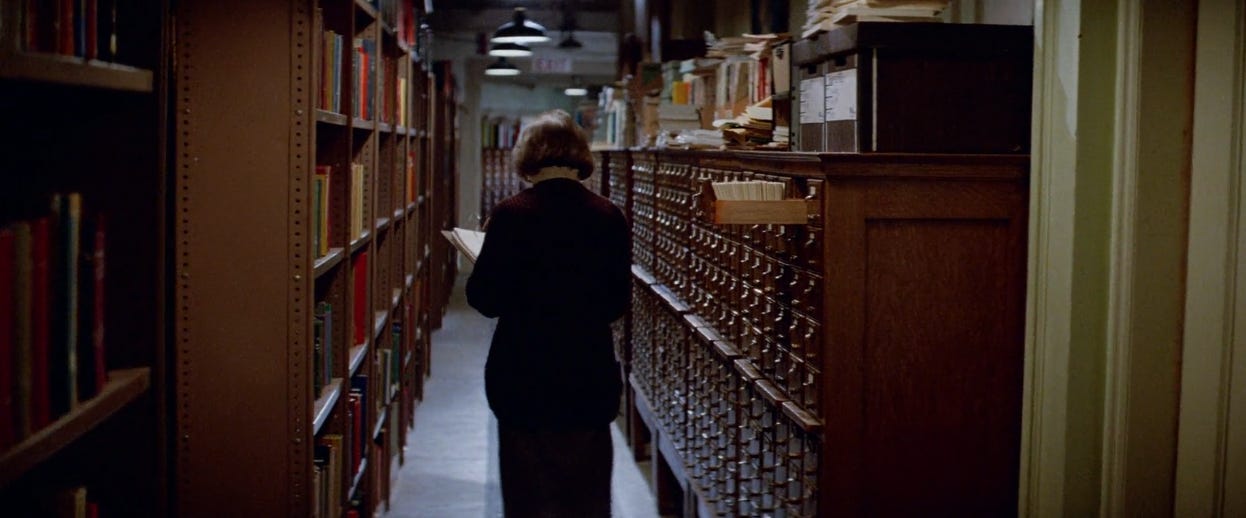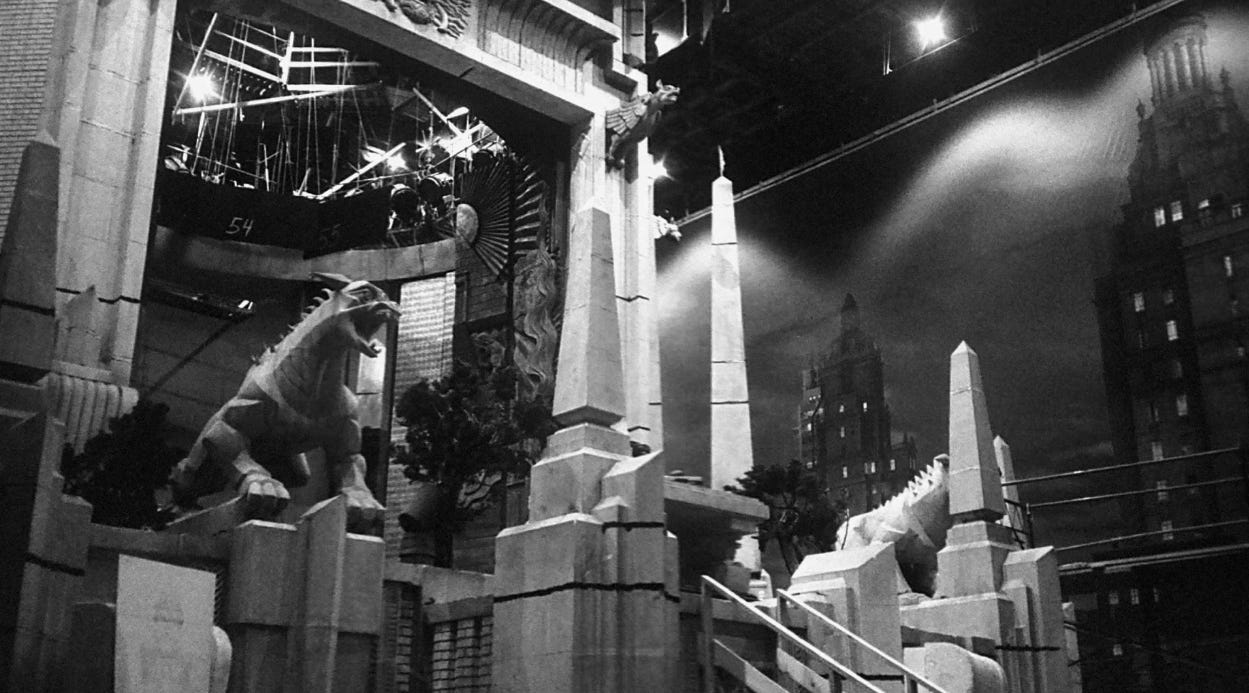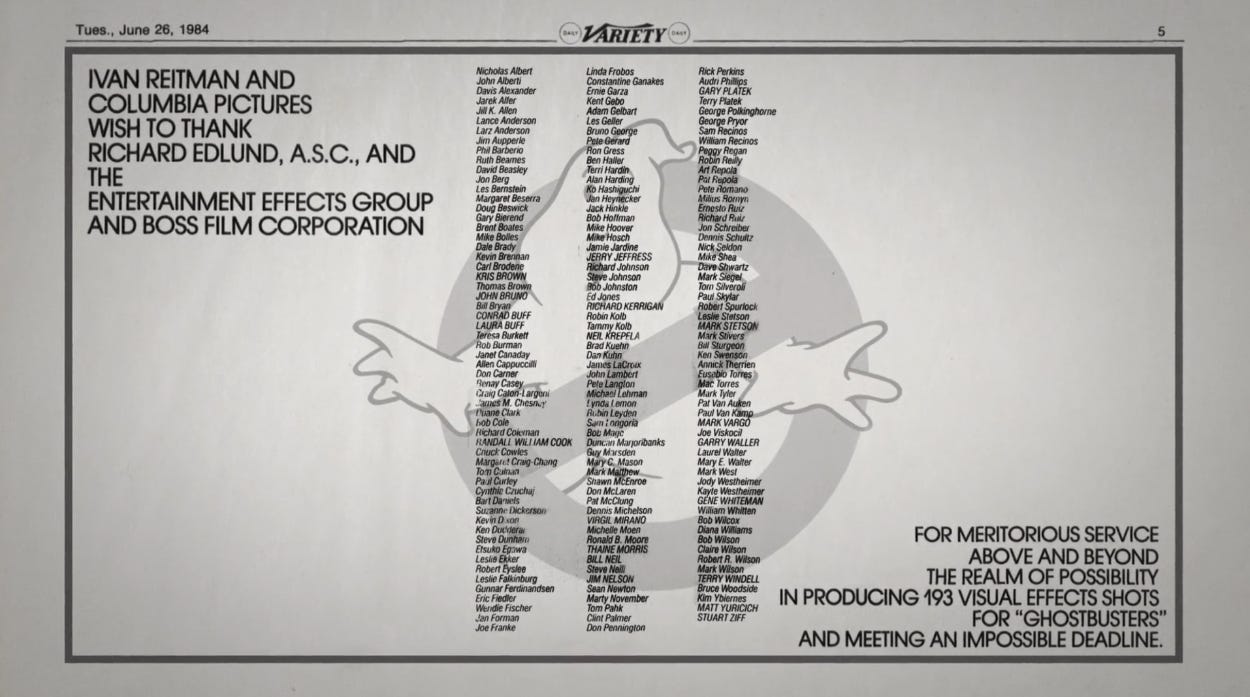Through The Looking Glass: The Old Becomes The (Refined) New
With "Ghostbusters: Afterlife" out in cinemas, join me as I take a look at some of the visual effects of the original Ghostbusters
Ghostbusters (1984) became a popular classic. Ivan Reitman (director/producer), apparently claimed: "I knew we were a hit the second weekend of release when I was walking through Manhattan, there were kiosks at every corner with guys selling illegal, black market t-shirts with sayings from the movie and the logo all over it".1 On IMDB, it currently holds a 7.8 audience score with 389,000 votes. For many reasons, it's now obvious that it has had, in some form or another, enduring impact in the popular imagination.2
I didn't like it. It has a terrible love story (bad couple chemistry), poorly written dialogue and delivery, and above all, it isn't funny. Roger Ebert seems to have liked it, but he made a figurative observation that also points to the comedy department: "It is not a complete vindication for big-budget comedies, since it's still true, as a general rule, that the more you spend, the fewer laughs you get".3 I didn't laugh. Not once. But I was curious about the visual effects.
These were pre-CGI times. As you can see above, Slimer, one of the iconic paranormal creatures seen in the film, was done by a combination of practical effects and optical compositing. A practical effect is a special effect produced physically, without the aid of computer-generated imagery. Ideally, it shouldn't require the help from post-production techniques. Under that scenario, the effect should take its final form in-camera. The library cards swirling around at the beginning of the film are one example. It was achieved by placing a fake wall where several crew members could hide, and on cue, would manually open the drawers and blow air through air jets.4 But sometimes additional help is needed, and Slimer also required a technique called optical compositing.
Compositing is "the process or technique of combining visual elements from separate sources into single images, often to create the illusion that all those elements are part of the same scene".5 Today, the process is largely (or completely) done by using computer software, but Ghostbusters used the optical approach (think of analog instead of digital), which normally involves an optical printer, "[…] a device consisting of one or more film projectors mechanically linked to a movie camera. It allows filmmakers to re-photograph one or more strips of film".6 The technique and such printers were hardly new by the time of shooting. Dan Aykroyd (writer), gives an honest account regarding their contribution: "We're just doing the modern version of the old time ghost movies" (YouTube, Ghostbusters.net, 2m 48s, above).
Older versions of the technique, some of them using a different process, achieved the same goal.7 Take a look at some shots of The Phantom Carriage (Körkarlen), a Swedish silent film released in 1921:
And here is Ghostbusters' modern result. If you ask me, it doesn't look extraordinarily different:
There is a higher degree of sophistication though. While The Phantom Carriage used actors in traditional wardrobe, Ghostbusters used puppetry made of specialised materials and intricate controls, in addition of more calculated camera movements. Slimer, for instance, had to be controlled by several technicians who had to syncronise its movements in order to perform.
Other relevant creatures in the show are the Terror Dogs, who were puppets animated using stop-motion for action scenes, and mechanical sculptures for stand-still shots. The composites of stop-motion animation and live action footage are the worst effects in the film. Consider the following two shots:
The marked difference between the two, from a viewer's perspective, is the skin colour of the creature. This is likely due to a loss of detail as a result of the stop-motion animation and the optical compositing used in the first shot. Because the second one it's just a mechanical sculpture being filmed on-site, it integrates smoothly with its environment. It's important to know that they are contiguous shots, separated briefly by a cut of a human being trying to scape. The contrast is eye-catching, and, unfortunately, detrimental to the illusion.
Check out the following shots from Jason and the Argonauts (1963). Although they also use stop-motion animation, the creatures integrate better with all the other elements in the shot (pay attention to the lighting). The 'genuineness' of the illusion is preserved to a better extent.
Among the other effects in the film are matte paintings (usually for establishing shots), miniature sets, hand-drawn animation (beam effects), and the construction of a 1 million USD set as tall as a six-story building where the final battle takes place.8 It was constructed on stage 16, Burbank lot of Warner Bros. studios, and Ivan Reitman (director), says that even Steven Spielberg, who was accustomed to work in "humongous" sets, came to visit it.9
The set has the peculiarity of being the host of basically all the effects seen previously in the film, plus a massive fire explosion using a miniature version of it. When I first watched it a few days ago, I couldn't help but say to myself: "C'mon! That explosion was so big they should be dead!". To my amusement, apparently the director thought the same thing. John Bruno, visual effects art director, tells us: "When [the director] saw it he wanted us to re-shoot it. He was really pissed [chuckles]. He said: 'They would've been killed!'. [Pause] Well, yeah, isn't that the joke?"10 The "solution" was that, right before the explosion, the characters move away from the frame (supposedly dodging the blast).
Nooo! It still doesn't work! Everything went kaputt!
As a curiosity, here's a YouTube user who decided to improve some of the effects shots using a 4K source. I recommend watching all of it. He definitely upgrades the Terror Dog shot that I critised above (7m 14s).
And as a final and bitter-sweet anecdote, there were approximately 162 people that worked on the visual effects under the Boss Film Corporation. However, not everyone's name was put on the end credits. Sam Longoria, an assistant cameraman, engineer/machinist, recalls that his wife didn't see his name in the credits and asked him: "So where were you everyday for a year?" These people, he claims, worked up to 20 hours a day, six to seven days a week and didn't get any recognition from the studio, which apparently said that the company could only have so many credits (?). "I don't know if they were running out of letters", jokes Longoria. Terri Hardin Jackson, puppeteer, says that Richard Edlund, founder of Boss Film Corporation, took a full-page ad on Variety to include all the names that had been left out of the movie.11 A nice gesture.
I recommend watching the documentary Cleanin’ Up the Town: Remembering Ghostbusters (2019), which I've used as a source for most of my footnotes references. They did a great job researching the material. There's plenty of goodies to discover! And I leave you with another documentary:
The documentary Cleanin' Up the Town: Remembering Ghostbusters (2019), in its first three minutes, provides a compelling summary about the movie's reception by the media, talent involved, and it's performance at the box office
Ebert, Roger (8 Jun 1984), Film Review: "Ghostbusters", Rogerebert.com. Retrieved 1 Jan 2022. Link 1 (Original) Link 2 (Web Archive). Variety's contemporary film review stated in its headline that the film's "[g]ags & special effects scare pic misses its mark". Source: "Cleanin' Up the Town: Remembering Ghostbusters" (Bueno Productions Ltd., 2019), 1m 56s. The idea is that, unsurprisingly, some of us didn't find the movie that funny
For the library cards, see "Cleanin' Up the Town: Remembering Ghostbusters" (Bueno Productions Ltd., 2019), 26m 35s. For the fake wall, see reference 1.
Ibid, Retrieved 2 Jan 2022.
For The Phantom Carriage, film-makers used the double exposure. In the audio commentary track of the 2011 Blu-ray edition from The Criterion Collection, film historian Casper Tybjerg states (21m 30s): "The effects were done in-camera. That is, the background image was shot first, then the film was rewound inside the camera, and then the ghostly figures were shot, often against a completely black background"
According to a Variety press article, shown in "Cleanin' Up the Town: Remembering Ghostbusters" (Bueno Productions Ltd., 2019), 1h 36m 23s
Interview, as seen in "Cleanin' Up the Town: Remembering Ghostbusters" (Bueno Productions Ltd., 2019), 1h 36m 12s
Ibid, 1h 54m 27s
Ibid, 1h 57m 36s



















